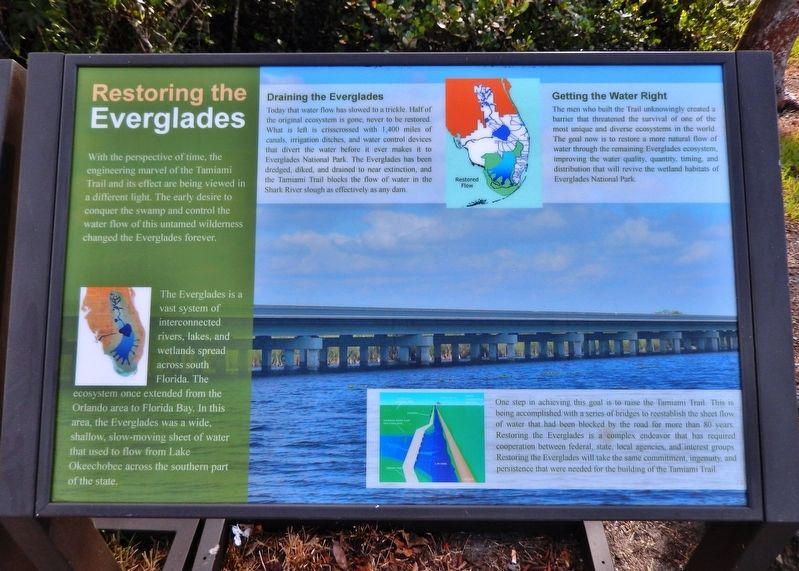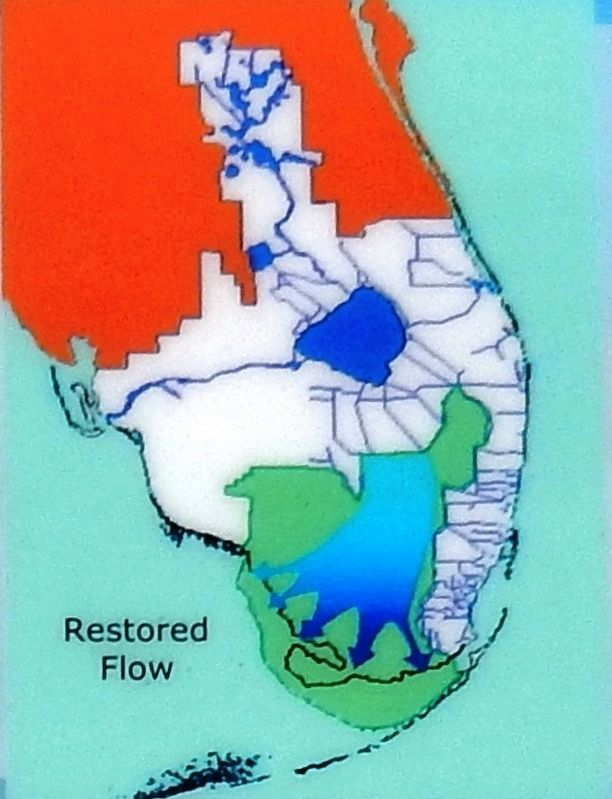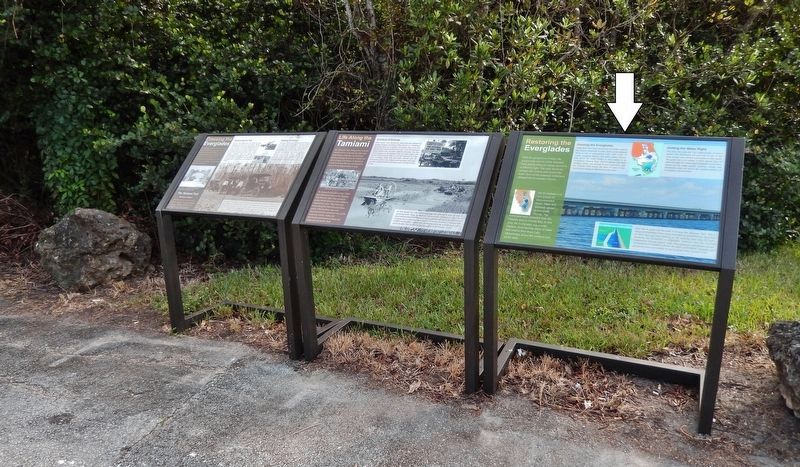Miami in Miami-Dade County, Florida — The American South (South Atlantic)
Restoring The Everglades
With the perspective of time, the engineering marvel of the Tamiami Trail and its effect are being viewed in a different light. The early desire to conquer the swamp and control the water flow of this untamed wilderness changed the Everglades forever.
The Everglades is a vast system of interconnected rivers, lakes, and wetlands spread across south Florida. The ecosystem once extended from the Orlando area to Florida Bay. In this area, the Everglades was a wide, shallow, slow-moving sheet of water that used to flow from Lake Okeechobee across the southern part of the state.
Draining the Everglades
Today that water flow has slowed to a trickle. Half of the original ecosystem is gone, never to be restored. What is left is crisscrossed with 1,400 miles of canals, irrigation ditches, and water control devices that divert the water before it ever makes it to Everglades National Park. The Everglades has been dredged, diked, and drained to near extinction, and the Tamiami Trail blocks the flow of water in the Shark River slough as effectively as any dam.
Getting the Water Right
The men who built the Trail unknowingly created a barrier that threatened the survival of one of the most unique and diverse ecosystems in the world. The goal now is to restore a more natural flow of water through the remaining Everglades ecosystem, improving the water quality, quantity, timing, and distribution that will revive the wetland habitats of Everglades National Park.
One step in achieving this goal is to raise the Tamiami Trail. This is being accomplished with a series of bridges to reestablish the sheet flow of water that had been blocked by the road for more than 80 years. Restoring the Everglades is a complex endeavor that has required cooperation between federal, state, local agencies, and interest groups. Restoring the Everglades will take the same commitment, ingenuity, and persistence that were needed for the building of the Tamiami Trail.
Topics. This historical marker is listed in these topic lists: Environment • Roads & Vehicles • Waterways & Vessels.
Location. 25° 45.65′ N, 80° 45.979′ W. Marker is in Miami, Florida, in Miami-Dade County. Marker is on Shark Valley Loop Road south of Tamiami Trail (Southwest 8th Street) (U.S. 41), on the left when traveling south. Marker is located at the intersection of Shark Valley Loop Road and Old Tamiami Trail, near the entrance to Everglades National Park Shark Valley Visitor Center. Touch for map. Marker is in this post office area: Miami FL 33194, United States of America. Touch for directions.
Other nearby markers. At least 2 other markers are within walking distance of this marker. Life Along the Tamiami (here, next to this marker); Crossing the Everglades (here, next to this marker).
Related markers. Click here for a list of markers that are related to this marker. Tamiami Trail and the Everglades
Also see . . .
1. Tamiami Trail Modifications. National Park Service entry
The Tamiami Trail has long been recognized as one of the primary barriers to flow of water through the ecosystem. The need to eliminate barriers to overland flow of water in the Everglades is now considered one of the indisputable tenets of restoration. Science informs us that it is not sufficient to simply provide a particular volume of water to these wetlands to attain restoration. Flows must mimic the natural water depths and flooding durations, be distributed across this landscape in a manner that best approximates historical flow patterns, and travel at sufficient velocities. Analyses conducted by the National Park Service and the U.S. Army Corps of Engineers evaluated the alternatives and affirmed that four spans of bridging totaling 5.5 miles and road raising, provides the greatest environmental benefits. (Submitted on April 14, 2019, by Cosmos Mariner of Cape Canaveral, Florida.)
2. Restoration of the Everglades. Wikipedia entry
The restoration of the Everglades is an ongoing effort to remedy damage inflicted on the environment of southern Florida during the 20th century. It is the most expensive and comprehensive environmental repair attempt in history. After decades of destructive practices, both state and federal agencies are looking for ways to balance the needs of the natural environment in South Florida with urban and agricultural centers that have recently and rapidly grown in and near the Everglades. (Submitted on April 14, 2019, by Cosmos Mariner of Cape Canaveral, Florida.)
Credits. This page was last revised on May 1, 2021. It was originally submitted on April 14, 2019, by Cosmos Mariner of Cape Canaveral, Florida. This page has been viewed 173 times since then and 9 times this year. Photos: 1, 2, 3, 4. submitted on April 14, 2019, by Cosmos Mariner of Cape Canaveral, Florida.



